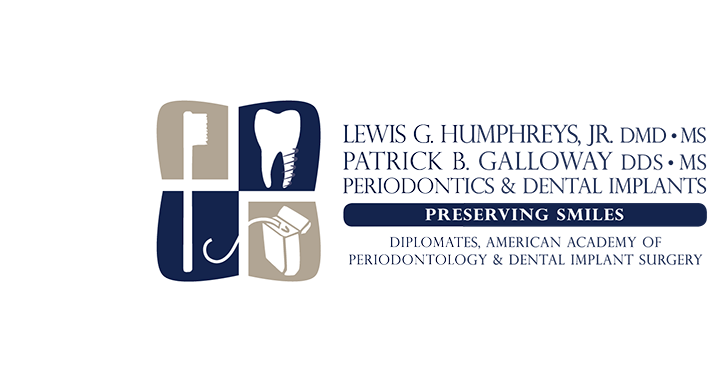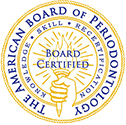Advanced Technology

We are constantly striving to provide our patients with the finest periodontal care available. Our investment in advanced technology means a long-term investment in your future. State-of-the-art technology facilitates informed decision-making and enables patients to make wise choices concerning their oral health. Dr. Humphreys and Dr. Galloway offer the latest dental technology for your benefit.
Bone Regeneration
Traditionally, gum disease was treated by eliminating the gum pockets - trimming away the infected gum tissue and re-contouring the uneven bone tissue. Although this is still an effective way of treating gum disease, new and more sophisticated procedures are used routinely today.
Guided tissue bone regeneration "regenerates" the previously lost gum and bone tissue. Most techniques utilize membranes, which are inserted over the bone defects. Some of these membranes are bio-absorbable and some require removal. Other regenerative procedures involve the use of bioactive gels.
Eliminating existing bacteria and regenerating bone and tissue helps to reduce pocket depth and repair damage caused by the progression of periodontal disease. With a combination of daily oral hygiene and professional maintenance care, you'll increase the chances of keeping your natural teeth – and decrease the chances of serious health problems associated with periodontal disease.
Computers
Our computer system is designed to efficiently manage complex information. Our system manages data on periodontal treatment as well as financial arrangements. We use voice activated recording devices with color-coded reports to diagnose and evaluate the results of therapy. We use the latest Dentrix software to ensure efficient, competent service for you.
CBCT Scan
Conebeam computed tomography (CBCT) scans are very helpful in planning placement of dental implants. Our software program allows Dr. Humphreys and Dr. Galloway to plan and place implants in the most optimal location to assist your referring dentist in fabricating the most ideal restoration for you.
Data Integration and Security
Dr. Humphreys and Dr. Galloway utilize a comprehensive messaging, conferencing and communication program designed to assist you with appointment reminders, automated text messages, case collaboration with your referring dentist, follow-up communications, on-hold messaging, recall reminders and website design.
Dental Implants
We have the ability to place various types of dental implants. We offer a variety of different implant systems that can enhance your comfort and function. We work closely with your referring dentist to choose the most beneficial implant system for your needs and tailor your treatment to provide the best final restoration for you.
Dental implants have several component parts. The implant itself is a titanium screw that is placed in the jawbone to serve as a mechanical replacement of the tooth root. After a period of healing, normally three months, a second component, the abutment, is attached to the implant body. Abutments vary from "snap" attachments for dentures, to posts for crown and bridgework. A new scanning technology allows for the fabrication of "custom milled abutments." These abutments help create tissue conditions around your new crown or bridge work which are both esthetic and easier to clean. Please see our DENTAL IMPLANTS page for more information.
All On 4 Dental Implants
Patients who have trouble wearing a conventional denture or who desire a full arch fixed prosthesis may benefit greatly from the All on 4 dental implant concept. Four precisely placed dental implants in the upper or lower jaw can serve to support a fixed restoration that replaces all of your teeth in that jaw. A screw retained dental prosthesis is attached to the implants giving the patient the security of something that does not move or fall out. In many cases, teeth can be extracted, the implants placed, and a temporary denture affixed in the same day.
Immediate Implants
An immediate dental implant is a dental implant that is placed in the jawbone immediately after a dental tooth extraction. It is usually placed at the same visit as the dental extraction but it can be done within two weeks after the dental tooth extraction and still be considered an immediate dental implant. If a crown or dental bridge is placed on an immediate dental implant to restore the tooth, this is considered immediate loading. Immediate loading of an immediate dental implant is the most favorable option for any patient.
Key Advantages to an Immediate Dental Implant:
- Fixed tooth replacement that looks as good or better than the extracted tooth
- One dental surgery and no stitches
- Helps preserve gum tissue
- Can be less painful
Digital Radiography
This form of computerized radiography uses a standard dental x-ray generator as its radiation source. The "zoom" capabilities allow Dr. Humphreys and Dr. Galloway to view localized areas of pathology and provide you with a better diagnosis. Digital radiographs have the advantage of allowing our office to share images quickly with your referring dentist, Digital radiography also reduces radiation exposure 80–90%.
Heart Monitor
We use heart monitors to ensure your safety and wellbeing during all surgical procedures. Dr. Humphreys, Dr. Galloway, and their team realize that the key component of any thorough periodontal appointment is patient assessment. While there are several tools used for conducting screenings and examinations for oral health, other aspects of patient health that may be related to dental heath are often overlooked. A patient’s blood pressure is one of these parameters. Appropriate monitoring of blood pressure cannot only improve outcomes of dental care but also play a role in improving the overall health of patients.
IV Sedation
Dr. Humphreys and Dr. Galloway have undergone rigorous specialized training before administering intravenous sedation. Their experience and expert knowledge of the physical and pharmacokinetic properties of sedative drugs and their effects is a critical factor for ensuring IV sedation safety. Dr. Humphreys and Dr. Galloway have both received special accreditation and licensing necessary to practice IV sedation dentistry including official training in Advanced Cardiac Life Support (ACLS). Dr. Humphreys and Dr. Galloway’s team has also undergone extensive cardiopulmonary resuscitation (CPR) training.
Continuous monitoring of the patient throughout the IV sedation procedure is a crucial factor for safety. We monitor heart rate and rhythm, blood pressure, oxygen and CO2 levels.
The strict regulations on IV sedation use, combined with advanced training and licensing requirements for Dr. Humphreys and Dr. Galloway have helped IV sedation dentistry to have an excellent safety record.
Lasers
In dentistry, lasers are used for a variety of procedures, including dental surgery, filling cavities, and whitening teeth. In periodontics, lasers can be used to treat deep pockets, promote soft tissue healing, and perform many periodontal plastic surgical procedures.
Panorex
The Panoramic x-ray provides Dr. Humphreys and Dr. Galloway with a panoramic view of the oral cavity and provides information about supporting bone, sources of infection, tumors, and cysts. The Panoramic x-ray shows more of the mouth and surrounding structures, but less detail of individual teeth, than small films. It is a useful diagnostic tool for patients who are considering dental implants.





